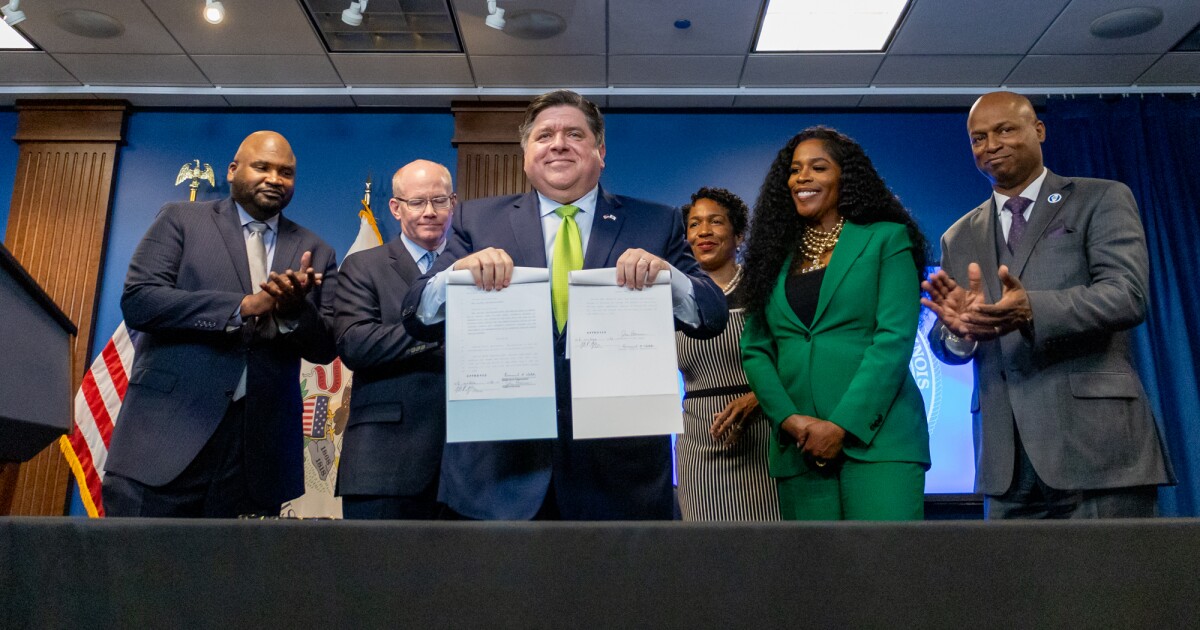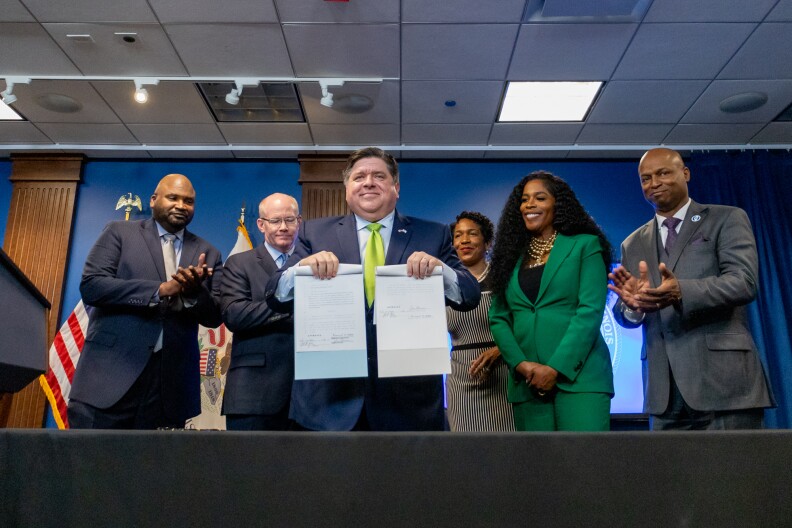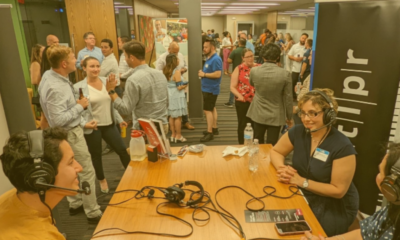Politics
Illinois Gov. J.B. Pritzker signs $53.1 billion state budget

[ad_1]

CHICAGO – Illinois Gov. J.B. Pritzker on Wednesday signed the state’s $53.1 billion spending plan for the upcoming fiscal year, the largest in state history.The signing caps months of work — and tension — among top Democratic leaders in Springfield and within the governor’s office.Pritzker said Wednesday the budget is a demonstration of “fiscal responsibility,” pointing to the $198 million that will head to the state’s “rainy day” fund, bringing it to a record balance of over $2.2 billion. It will also make the full payment into the state’s pension systems that is required by law.House Speaker Emanuel “Chris” Welch, D-Hillside, and Senate President Don Harmon, D-Oak Park flanked Pritzker at the signing alongside Democrats’ chief budget negotiators in the state’s downtown Chicago office building.Sen. Elgie Sims, D-Chicago, the lead budget negotiator for the Senate, pointed to several programs that he said will benefit vulnerable Illinoisans, including a tax credit for low-income families and increased wages for those who work with disabled people.That tax credit will cost $50 million. Qualifying families with children under age 12 will receive a credit of 20% of the state’s Earned Income Tax Credit in calendar year 2024 and 40% in the following year, which is projected to cost $100 million. Pritzker had proposed such a credit for children up to age three, but lawmakers expanded the credit.
Andrew Adams
/
Capitol News IllinoisIllinois Senate President Don Harmon, D-Oak Park, speaks to reporters before Gov. JB Pritzker signs the fiscal year 2025 budget into law.
But even some of the budget’s strongest boosters hinted at the contentious process that produced it.“This, by no means, was an easy budget, but this is a good budget that invests in families all over the state of Illinois,” Rep. Jehan Gordon-Booth, D-Peoria, said Wednesday.Democrats who control the General Assembly pushed the budget package over the finish line last week after a marathon all-night session in the Illinois House that highlighted internal strife within the majority party.Upon Pritzker’s signing of the budget, Republicans were quick to criticize it, echoing initial opposition shared last week. The Senate’s top Republican, Sen. John Curran, R-Downers Grove, denounced the budget’s use of state funds to provide health care benefits for noncitizen residents of the state, calling the situation “grossly unfair” in a Wednesday statement.The budget includes $629 million – including $440 million general funds – for that health care program, as well as $182 million to provide shelter, health care and other services for recently arrived migrants, many of whom have been bused to the state from Texas.Republicans uniformly voted against the budget package with the exception of a measure that does away with the state’s 1% tax on groceries, but even some Democrats balked at the budget and voted against either the spending or revenue plans last week.Though they ultimately voted for the budget, a few Democrats took time during the Senate’s debate on the budget package to express mild disappointment with spending priorities, saying they wished the state had more resources for youth employment programs and public universities.But while a trio of Democrats’ ‘no’ votes on the spending and revenue bills had no bearing on the budget’s passage in the Senate, a bloc of opposition in the House nearly derailed its budget vote in the wee hours of the morning last Wednesday.Amid attendance issues as the night wore on, it took Democratic leaders three tries – and a temporary waiving of the chamber’s own rulebook – to get the minimum 60 votes needed to pass the bill containing new taxes. Earlier in the evening, the spending bill passed by a narrow margin.During debate over the revenue bill, State Rep. Fred Crespo, D-Hoffman Estates, lamented that leadership didn’t consider spending controls he’d suggested earlier this spring in his role as chair of the House’s committee on appropriations for general services.
Andrew Adams
/
Capitol News IllinoisIllinois House Speaker Emanuel “Chris” Welch, D-Hillside, speaks to reporters before Gov. JB Pritzker signs the fiscal year 2025 budget into law.
Those suggestions included a hiring freeze for state workers and only giving state agencies 95% of the funds they said they’d need for the fiscal year – allowing them the opportunity to lobby for the remaining 5% next May if the money ended up being truly needed.He warned about a looming fiscal cliff before voting against the bill, saying, “at this rate, ladies and gentlemen, we’re gonna run out of taxpayer dollars to spend.”Asked about Crespo’s comments for the second time on Wednesday, Pritzker pushed back, claiming “most Democrats” wouldn’t agree with Crespo’s ideas. The governor’s criticism followed social media posts from two of his top deputies aimed at Comptroller Susana Mendoza, who earlier this week told Quincy-based TV station WGEM that she’d have liked to see “perhaps some more cuts across the board.”The governor also painted Mendoza’s suggestions as more in line with Republicans than the pair’s shared party.“Well, I want to remind all of you that across-the-board budget cuts – this idea is not an idea that Democrats believe in,” Pritzker said Wednesday. “This idea that you can just go across the board and cut 5% of the budget and not have a very deleterious effect on people all across the state.”Revenues and taxesWhile more than $1.1 billion in added revenue was needed to balance the books, the final revenue plan – which Pritzker did not sign on Wednesday but said he planned to without changes – doesn’t include any personal income tax increases for Illinoisans.The final plan did not slow the increase of the state’s standard deduction, a sum millions of Illinoisans subtract from their taxable income each year. It will grow to $2,775 after lawmakers scrapped Pritzker’s plan to cap it at $2,550.But businesses claiming previous-year losses on their taxes will be on the hook for another $526 million collectively after lawmakers voted to extend an expiring cap on corporate net operating losses. The cap will actually increase from $100,000 in the current fiscal year to $500,000, but the move is considered revenue-generating because without the change in law, there would be no such cap in place for FY25.Other revenue measures include:$200 million raised by increasing the tax rate on sportsbooks from 15% to a graduated rate of 20% to 40% based on revenues. $101 million raised by capping a tax discount claimed by retailers at $1,000 monthly. $200 million raised by redirecting $150 million from the Road Fund and $50 million from the Leaking Underground Storage Tank Fund to public transit, freeing up that amount in general revenue spending. $25 million raised by subjecting “re-renters” of hotel rooms to an existing state hotel tax. $35 million in infrastructure funding raised by increasing the tax on video gambling revenues by one percentage point.An associated budget bill that is yet to be signed eliminates the state’s grocery tax beginning in 2026, but it gives municipalities the authority to install their own such tax without a referendum to make up for the revenue lost from the state’s tax.EducationPritzker’s plan included several increases for K-12 and higher education, including the annual $350 million bump in K-12 education funding, called for by a 2017 law that overhauled Illinois’ school funding formula. Other increases include:Another $32.7 million increase for transportation and special education reimbursements for schools. Full funding for Pritzker’s “Smart Start” plan aimed at adding 5,000 preschool seats across the state and providing workforce grants. That includes $75 million in additional Illinois Early Childhood Block Grant funding, about $200 million to stabilize operational funding for child care providers and $5 million to expand a Department of Human Services home visiting program. $14 million to launch the newly created Department of Early Childhood, which Pritzker has promised would streamline services currently provided by three different state agencies. $45 million for a teacher vacancy pilot program to help underserved districts with teacher retention.A 2% – or $30.6 million – increase for community colleges and public universities. A $10 million increase to Monetary Award Program grants for lower-income college students.$575 million for deferred maintenance and construction at higher education facilities, including $450 million for universities and $125 million for community colleges. Health care and human servicesThe budget also allocated $10 million to erase more than $1 billion in medical debt for an estimated 300,000 Illinoisans through partnership with the nonprofit Undue Medical Debt. House Bill 5290, which has not yet been signed, laid out that applicants must earn 400% of the federal poverty level or less. Other health and human services funding include:A $1 hourly increase for direct service professionals who serve individuals with intellectual and developmental disabilities in community-based settings. An increase totaling $70 million for Community Care Program workers serving older adults who can’t live independently.$4 million to create a statewide maternal health plan and distribute grants to community-based reproductive health care providers.A $70 million increase for safety net hospitals. A $90 million increase for Home Illinois, a program created last year to address homelessness, bringing total funding to $290 million.$1 million for a low-income diaper program. $13 million for the Mental Health Early Action on Campus Act grants – a line-item Pritzker had proposed drastically cutting but lawmakers ultimately funded in full.$50.3 million to the Department of Children and Family services aimed at increasing staff size by 392 positions and providing “rate reform” for the providers that partner with the state. State government and infrastructureThe budget included funding for a 5% pay hike for lawmakers’ base salary to $93,712, as well as salary increases for constitutional officers, such as the governor, comptroller and treasurer. State law sets the pay for those individuals to increase annually with inflation, and lawmakers took no action to stop it from occurring in FY25. Pritzker, a billionaire, does not take a state salary.The budget also included $5.3 billion in appropriations and bonding authority for road and bridge projects, with over $3.5 billion in new bonding authority for other infrastructure. Some of that funding includes:$900 million for renovation at state prisons, including a possible tear down and rebuild of Stateville and Logan Correctional Centers.$500 million to support the development of a regional quantum information science and technology campus. Another bill allowing the Department of Commerce and Economic Opportunity to designate “quantum campuses” also lays out infrastructure and business incentives to lure developers of new-age higher-speed computing technology to the state. $157 million for additional funding to support construction of the new Illinois Department of Public Health laboratory in the Chicago area and rehabilitation of the Carbondale laboratory. Capitol News Illinoisis a nonprofit, nonpartisan news service covering state government. It is distributed to hundreds of newspapers, radio and TV stations statewide. It is funded primarily by the Illinois Press Foundation and the Robert R. McCormick Foundation, along with major contributions from the Illinois Broadcasters Foundation and Southern Illinois Editorial Association.
[ad_2]
Source link
Politics
Poll: Support for Missouri abortion rights amendment growing

[ad_1]

A proposed constitutional amendment legalizing abortion in Missouri received support from more than half of respondents in a new poll from St. Louis University and YouGov.That’s a boost from a poll earlier this year, which could mean what’s known as Amendment 3 is in a solid position to pass in November.SLU/YouGov’s poll of 900 likely Missouri voters from Aug. 8-16 found that 52% of respondents would vote for Amendment 3, which would place constitutional protections for abortion up to fetal viability. Thirty-four percent would vote against the measure, while 14% aren’t sure.By comparison, the SLU/YouGov poll from February found that 44% of voters would back the abortion legalization amendment.St. Louis University political science professor Steven Rogers said 32% of Republicans and 53% of independents would vote for the amendment. That’s in addition to nearly 80% of Democratic respondents who would approve the measure. In the previous poll, 24% of Republicans supported the amendment.Rogers noted that neither Amendment 3 nor a separate ballot item raising the state’s minimum wage is helping Democratic candidates. GOP contenders for U.S. Senate, governor, lieutenant governor, treasurer and secretary of state all hold comfortable leads.“We are seeing this kind of crossover voting, a little bit, where there are voters who are basically saying, ‘I am going to the polls and I’m going to support a Republican candidate, but I’m also going to go to the polls and then I’m also going to try to expand abortion access and then raise the minimum wage,’” Rogers said.Republican gubernatorial nominee Mike Kehoe has a 51%-41% lead over Democrat Crystal Quade. And U.S. Sen. Josh Hawley is leading Democrat Lucas Kunce by 53% to 42%. Some GOP candidates for attorney general, secretary of state and treasurer have even larger leads over their Democratic rivals.
Brian Munoz
/
St. Louis Public RadioHundreds of demonstrators pack into a parking lot at Planned Parenthood of St. Louis and Southwest Missouri on June 24, 2022, during a demonstration following the Supreme Court’s reversal of a case that guaranteed the constitutional right to an abortion.
One of the biggest challenges for foes of Amendment 3 could be financial.Typically, Missouri ballot initiatives with well-funded and well-organized campaigns have a better chance of passing — especially if the opposition is underfunded and disorganized. Since the end of July, the campaign committee formed to pass Amendment 3 received more than $3 million in donations of $5,000 or more.That money could be used for television advertisements to improve the proposal’s standing further, Rogers said, as well as point out that Missouri’s current abortion ban doesn’t allow the procedure in the case of rape or incest.“Meanwhile, the anti side won’t have those resources to kind of try to make that counter argument as strongly, and they don’t have public opinion as strongly on their side,” Rogers said.There is precedent of a well-funded initiative almost failing due to opposition from socially conservative voters.In 2006, a measure providing constitutional protections for embryonic stem cell research nearly failed — even though a campaign committee aimed at passing it had a commanding financial advantage.Former state Sen. Bob Onder was part of the opposition campaign to that measure. He said earlier this month it is possible to create a similar dynamic in 2024 against Amendment 3, if social conservatives who oppose abortion rights can band together.“This is not about reproductive rights or care for miscarriages or IVF or anything else,” said Onder, the GOP nominee for Missouri’s 3rd Congressional District seat. “Missourians will learn that out-of-state special interests and dark money from out of state is lying to them and they will reject this amendment.”Quade said earlier this month that Missourians of all political ideologies are ready to roll back the state’s abortion ban.“Regardless of political party, we hear from folks who are tired of politicians being in their doctor’s offices,” Quade said. “They want politicians to mind their own business. So this is going to excite folks all across the political spectrum.”
[ad_2]
Source link
Politics
Democrat Mark Osmack makes his case for Missouri treasurer

[ad_1]

Mark Osmack has been out of the electoral fray for awhile, but he never completely abandoned his passion for Missouri politics.Osmack, a Valley Park native and U.S. Army veteran, previously ran for Missouri’s 2nd Congressional District seat and for state Senate. Now he’s the Democratic nominee for state treasurer after receiving a phone call from Missouri Democratic Party Chairman Russ Carnahan asking him to run.“There’s a lot of decision making and processing and evaluation that goes into it, which is something I am very passionate and interested in,” Osmack said this week on an episode of Politically Speaking.Osmack is squaring off against state Treasurer Vivek Malek, who was able to easily win a crowded GOP primary against several veteran lawmakers including House Budget Chairman Cody Smith and state Sen. Andrew Koenig.While Malek was able to attract big donations to his political action committee and pour his own money into the campaign, Osmack isn’t worried that he won’t be able to compete in November. Since Malek was appointed to his post, Osmack contends he hasn’t proven that he’s a formidable opponent in a general election.“His actions and his decision making so far in his roughly two year tenure in that office have been questionable,” Osmack said.Among other things, Osmack was critical of Malek for placing unclaimed property notices on video gaming machines which are usually found in gas stations or convenience stores. The legality of the machines has been questioned for some time.As Malek explained on his own episode of Politically Speaking, he wanted to make sure the unclaimed property program was as widely advertised as possible. But he acknowledged it was a mistake to put the decals close to the machines and ultimately decided to remove them.Osmack said: “This doesn’t even pass the common sense sniff test of, ‘Hey, should I put state stickers claiming you might have a billion dollars on a gambling machine that is not registered with the state of Missouri?’ If we’re gonna give kudos for him acknowledging the wrong thing, it never should have been done in the first place.”Osmack’s platform includes supporting programs providing school meals using Missouri agriculture products and making child care more accessible for the working class.He said the fact that Missouri has such a large surplus shows that it’s possible to create programs to make child care within reach for parents.“It is quite audacious for [Republicans] to brag about $8 billion, with a B, dollars in state surplus, while we offer next to no social services to include pre-K, daycare, or child care,” Osmack said.Here’s are some other topics Osmack discussed on the show:How he would handle managing the state’s pension systems and approving low-income housing tax credits. The state treasurer’s office is on boards overseeing both of those programs.Malek’s decision to cut off investments from Chinese companies. Osmack said that Missouri needs to be cautious about abandoning China as a business partner, especially since they’re a major consumer of the state’s agriculture products. “There’s a way to make this work where we are not supporting communist nations to the detriment of the United States or our allies, while also maintaining strong economic ties that benefit Missouri farmers,” he said.What it was like to witness the skirmish at the Missouri State Fair between U.S. Sen. Josh Hawley and Democratic challenger Lucas Kunce.Whether Kunce can get the support of influential groups like the Democratic Senatorial Campaign Committee, which often channels money and staff to states with competitive Senate elections.
[ad_2]
Source link
Politics
As Illinois receives praise for its cannabis equity efforts, stakeholders work on system’s flaws

[ad_1]

Medical marijuana patients can now purchase cannabis grown by small businesses as part of their allotment, Illinois’ top cannabis regulator said, but smaller, newly licensed cannabis growers are still seeking greater access to the state’s medical marijuana customers.Illinois legalized medicinal marijuana beginning in 2014, then legalized it for recreational use in 2020. While the 2020 law legalized cannabis use for any adult age 21 or older, it did not expand licensing for medical dispensaries.Patients can purchase marijuana as part of the medical cannabis program at dual-purpose dispensaries, which are licensed to serve both medical and recreational customers. But dual-purpose dispensaries are greatly outnumbered by dispensaries only licensed to sell recreationally, and there are no medical-only dispensaries in the state.As another part of the adult-use legalization law, lawmakers created a “craft grow” license category that was designed to give more opportunities to Illinoisans hoping to legally grow and sell marijuana. The smaller-scale grow operations were part of the 2020 law’s efforts to diversify the cannabis industry in Illinois.Prior to that, all cultivation centers in Illinois were large-scale operations dominated by large multi-state operators. The existing cultivators, mostly in operation since 2014, were allowed to grow recreational cannabis beginning in 2019.Until recently, dual-purpose dispensaries have been unsure as to whether craft-grown products, made by social equity licensees — those who have lived in a disproportionately impacted area or have been historically impacted by the war on drugs — can be sold medicinally as part of a patient’s medical allotment.Erin Johnson, the state’s cannabis regulation oversight officer, told Capitol News Illinois last month that her office has “been telling dispensaries, as they have been asking us” they can now sell craft-grown products to medical patients.“There was just a track and trace issue on our end, but never anything statutorily,” she said.
Dilpreet Raju
/
Capitol News IllinoisThe graphic shows how cannabis grown in Illinois gets from cultivation centers to customers.
No notice has been posted, but Johnson’s verbal guidance comes almost two years after the first craft grow business went online in Illinois.It allows roughly 150,000 medical patients, who dispensary owners say are the most consistent purchasers of marijuana, to buy products made by social equity businesses without paying recreational taxes. However — even as more dispensaries open — the number available to medical patients has not increased since 2018, something the Cannabis Regulation Oversight Office “desperately” wants to see changed. Johnson said Illinois is a limited license state, meaning “there are caps on everything” to help control the relatively new market.Berwyn Thompkins, who operates two cannabis businesses, said the rules limited options for patients and small businesses.“It’s about access,” Thompkins said. “Why wouldn’t we want all the patients — which the (adult-use) program was initially built around — why wouldn’t we want them to have access? They should have access to any dispensary.”Customers with a medical marijuana card pay a 1% tax on all marijuana products, whereas recreational customers pay retail taxes between roughly 20 and 40% on a given cannabis product, when accounting for local taxes.While Illinois has received praise for its equity-focused cannabis law, including through an independent study that showed more people of color own cannabis licenses than in any other state, some industry operators say they’ve experienced many unnecessary hurdles getting their businesses up and running.The state, in fact, announced last month that it had opened its 100th social equity dispensary.But Steve Olson, purchasing manager at a pair of dispensaries (including one dual-purpose dispensary) near Rockford, said small specialty license holders have been left in the lurch since the first craft grower opened in October 2022.“You would think that this would be something they’re (the government) trying to help out these social equity companies with, but they’re putting handcuffs on them in so many different spots,” he said. “One of them being this medical thing.”Olson said he contacted state agencies, including the Department of Financial and Professional Regulation, months ago about whether craft products can be sold to medical patients at their retail tax rate, but only heard one response: “They all say it was an oversight.”This potentially hurt social equity companies because they sell wholesale to dispensaries and may have been missing out on a consistent customer base through those medical dispensaries.Olson said the state’s attempts to provide licensees with a path to a successful business over the years, such as with corrective lotteries that granted more social equity licenses, have come up short.“It’s like they almost set up the social equity thing to fail so the big guys could come in and swoop up all these licenses,” Olson said. “I hate to feel like that but, if you look at it, it’s pretty black and white.”Olson said craft companies benefit from any type of retail sale.“If we sell it to medical patients or not, it’s a matter of, ‘Are we collecting the proper taxes?’ That’s all it is,” he said.State revenue from cannabis taxes, licensing costs and other fees goes into the Cannabis Regulation Fund, which is used to fund a host of programs, including cannabis offense expungement, the general revenue fund, and the R3 campaign aiming to uplift disinvested communities.For fiscal year 2024, nearly $256 million was paid out from Cannabis Regulation Fund for related initiatives, which includes almost $89 million transferred to the state’s general revenue fund and more than $20 million distributed to local governments, according to the Illinois Department of Revenue.Medical access still limitedThe state’s 55 medical dispensaries that predate the 2020 legalization law, mostly owned by publicly traded multistate operators that had been operating in Illinois since 2014 under the state’s medical marijuana program, were automatically granted a right to licenses to sell recreationally in January 2020. That gave them a dual-purpose license that no new entrants into the market can receive under current law.Since expanding their clientele in 2020, Illinois dispensaries have sold more than $6 billion worth of cannabis products through recreational transactions alone.Nearly two-thirds of dispensaries licensed to sell to medical patients are in the northeast counties of Cook, DuPage, Kane, Lake and Will. Dual-purpose dispensaries only represent about 20 percent of the state’s dispensaries.While the state began offering recreational dispensary licenses since the adult-use legalization law passed, it has not granted a new medical dispensary license since 2018. That has allowed the established players to continue to corner the market on the state’s nearly 150,000 medical marijuana patients.But social equity licensees and advocates say there are more ways to level the playing field, including expanding access to medical sales.Johnson, who became the state’s top cannabis regulator in late 2022, expressed hope for movement during the fall veto session on House Bill 2911, which would expand medical access to all Illinois dispensaries.“We would like every single dispensary in Illinois to be able to serve medical patients,” Johnson said. “It’s something that medical patients have been asking for, for years.”Johnson said the bill would benefit patients and small businesses.“It’s something we desperately want to happen as a state system, because we want to make sure that medical patients are able to easily access what they need,” she said. “We also think it’s good for our social equity dispensaries, as they’re opening, to be able to serve medical patients.”Rep. Bob Morgan, D-Deerfield, who was the first statewide project coordinator for Illinois’ medical cannabis program prior to joining the legislature, wrote in an email to Capitol News Illinois that the state needs to be doing more for its patients.“Illinois is failing the state’s 150,000 medical cannabis patients with debilitating conditions. Too many are still denied the patient protections they deserve, including access to their medicine,” Morgan wrote, adding he would continue to work with stakeholders on further legislation.Capitol News Illinois is a nonprofit, nonpartisan news service covering state government. It is distributed to hundreds of newspapers, radio and TV stations statewide. It is funded primarily by the Illinois Press Foundation and the Robert R. McCormick Foundation, along with major contributions from the Illinois Broadcasters Foundation and Southern Illinois Editorial Association.
[ad_2]
Source link
-

 Politics2 years ago
Politics2 years agoPrenzler ‘reconsidered’ campaign donors, accepts vendor funds
-
Board Bills1 year ago
2024-2025 Board Bill 80 — Prohibiting Street Takeovers
-

 Business3 years ago
Business3 years agoFields Foods to open new grocery in Pagedale in March
-

 Board Bills3 years ago
Board Bills3 years ago2022-2023 Board Bill 168 — City’s Capital Fund
-

 Business3 years ago
Business3 years agoWe Live Here Auténtico! | The Hispanic Chamber | Community and Connection Central
-

 Entertainment2 years ago
Entertainment2 years agoOK, That New Cardinals/Nelly City Connect Collab Is Kind of Great
-

 Entertainment3 years ago
Entertainment3 years agoSt.Louis Man Sounds Just Like Whitley Hewsten, Plans on Performing At The Shayfitz Arena.
-

 Entertainment2 years ago
Entertainment2 years agoSt. Louis’ New Museum of Illusions Is Ready to Book Your Visit





